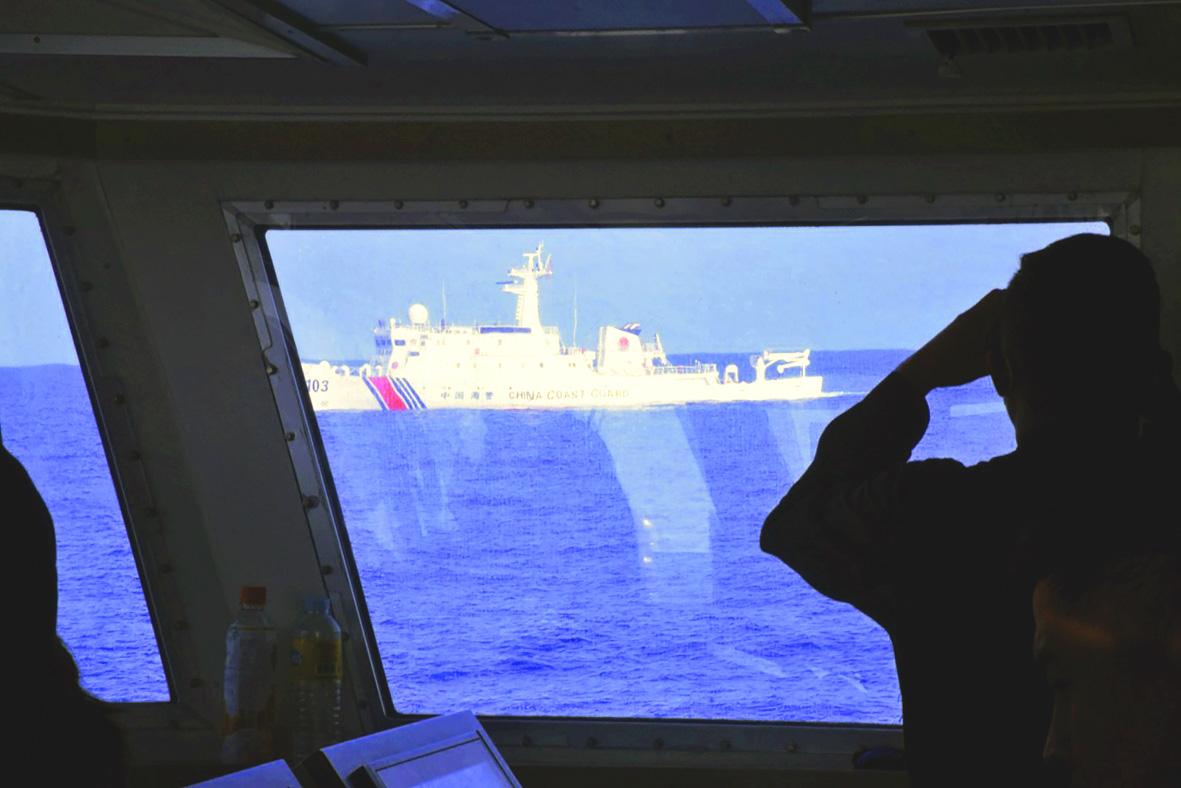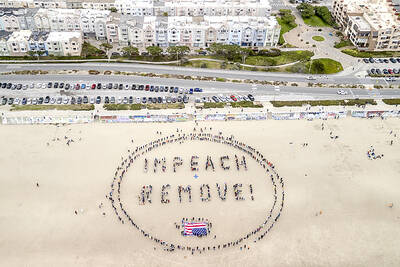A Chinese coast guard ship last month maneuvered for days near a research vessel deployed by Taiwanese and Philippine scientists to undertake a crucial survey of undersea fault lines west of the northern Philippines, sparking concerns among the scientists on board, officials said yesterday.
From March 25 to Wednesday last week, the scientists on the R/V Legend proceeded with their research on the Manila Trench, near the northwestern Philippine city of Vigan, despite the presence of the Chinese coast guard ship in the vicinity.
The Chinese coast guard’s proximity sparked concerns because the research vessel was towing a survey cable in the sea, a Philippine scientist said.

Photo: Philippine Coast Guard via AP
The ongoing offshore survey — a joint project of National Central University in Taiwan and the University of the Philippines’ National Institute of Geological Sciences — aims to help map offshore faults and other geologic features that could set off earthquakes, tsunamis and other potentially catastrophic hazards in the region.
The research, which ends on Wednesday next week, is partly funded by the Philippine Department of Science and Technology.
The Chinese coast guard ship maneuvered within 2 to 3 nautical miles (3 to 5km) of the R/V Legend for several days, Carla Dimalanta of the National Institute of Geological Sciences said.
“Its proximity to the research vessel was cause for concern, especially when the research vessel was towing a streamer cable for the scientific measurements that were being done,” Dimalanta said in an e-mail.
She did not say whether the Chinese coast guard ship warned the research vessel that it had illegally entered Chinese territorial waters and should immediately move away
The Chinese coast guard has often issued this radio warning to foreign ships and vessels cruising near its outposts in the South China Sea, which Beijing claims virtually in its entirety.
For decades, Taiwan, Brunei, China, Malaysia, the Philippines and Vietnam have been locked in an increasingly tense territorial standoff in the South China Sea.
The Manila Trench, which runs off the western coast of the main northern Philippine island of Luzon on the edge of the South China Sea has long been an area of concern because of the potential disaster it could unleash if a major earthquake and tsunami were generated in the busy waterway that borders several countries, including Taiwan, China and the Philippines.
Two officers said on condition of anonymity that the Philippine military was aware that the Chinese coast guard had been tracking the research vessel.
There was no immediate comment from Chinese embassy officials in Manila.
Late last month, the Philippine coast guard said that Chinese coast guard ships maneuvered dangerously close to its patrol ships at least four times in the vicinity of the disputed Scarborough Shoal (Huangyan Island, 黃岩島) off the northwestern Philippines over the past year.
The movement of the Chinese coast guard ships increased the risk of collision and contravened international safety regulations, the Philippine coast guard said at the time.
In one of those dangerous movements, a Chinese coast guard ship moved just 20m from a Philippine coast guard vessel and restricted its maneuvering space in the vicinity of the Scarborough Shoal in a “clear violation” of a 1972 international safety regulation that aims to prevent sea collisions, said the Philippine coast guard, which reported the incident to the Philippine Department of Foreign Affairs.
China’s seizure of Scarborough Shoal prompted the Philippines to bring the dispute to international arbitration.
In 2016, a UN-backed tribunal invalidated most of China’s claims and said it has contravened the rights of Filipinos to fish at the shoal.
China dismissed the ruling as a sham and continues to defy it, but has allowed Philippine fishers to return to the shoal under Philippine President Rodrigo Duterte’s administration, which has nurtured closer ties with Beijing.
Despite the two countries’ closer relations, sporadic territorial spats have persisted.
Two weeks ago, US Indo-Pacific Commander Admiral John Aquilino told reporters on board a US Navy reconnaissance aircraft that China has fully militarized three of the seven islands that it built in the disputed Spratly Islands (Nansha Islands, 南沙群島) in the South China Sea, arming them with anti-ship and anti-aircraft missile systems, laser and jamming equipment, and military aircraft in an increasingly aggressive move that threatens all nations operating in the disputed waters.
China said that its deployment of “necessary national defense facilities on its own territory is a right entitled to every sovereign country and is in line with international law, which is beyond reproach.”

Young women standing idly around a park in Tokyo’s west suggest that a giant statue of Godzilla is not the only attraction for a record number of foreign tourists. Their faces lit by the cold glow of their phones, the women lining Okubo Park are evidence that sex tourism has developed as a dark flipside to the bustling Kabukicho nightlife district. Increasing numbers of foreign men are flocking to the area after seeing videos on social media. One of the women said that the area near Kabukicho, where Godzilla rumbles and belches smoke atop a cinema, has become a “real

Two Belgian teenagers on Tuesday were charged with wildlife piracy after they were found with thousands of ants packed in test tubes in what Kenyan authorities said was part of a trend in trafficking smaller and lesser-known species. Lornoy David and Seppe Lodewijckx, two 19-year-olds who were arrested on April 5 with 5,000 ants at a guest house, appeared distraught during their appearance before a magistrate in Nairobi and were comforted in the courtroom by relatives. They told the magistrate that they were collecting the ants for fun and did not know that it was illegal. In a separate criminal case, Kenyan Dennis

APPORTIONING BLAME: The US president said that there were ‘millions of people dead because of three people’ — Vladimir Putin, Joe Biden and Volodymyr Zelenskiy US President Donald Trump on Monday resumed his attempts to blame Ukrainian President Volodymyr Zelenskiy for Russia’s invasion, falsely accusing him of responsibility for “millions” of deaths. Trump — who had a blazing public row in the Oval Office with Zelenskiy six weeks ago — said the Ukranian shared the blame with Russian President Vladimir Putin, who ordered the February 2022 invasion, and then-US president Joe Biden. Trump told reporters that there were “millions of people dead because of three people.” “Let’s say Putin No. 1, but let’s say Biden, who had no idea what the hell he was doing, No. 2, and

DEMONSTRATIONS: A protester said although she would normally sit back and wait for the next election, she cannot do it this time, adding that ‘we’ve lost too much already’ Thousands of protesters rallied on Saturday in New York, Washington and other cities across the US for a second major round of demonstrations against US President Donald Trump and his hard-line policies. In New York, people gathered outside the city’s main library carrying signs targeting the US president with slogans such as: “No Kings in America” and “Resist Tyranny.” Many took aim at Trump’s deportations of undocumented migrants, chanting: “No ICE [Immigration and Customs Enforcement], no fear, immigrants are welcome here.” In Washington, protesters voiced concern that Trump was threatening long-respected constitutional norms, including the right to due process. The